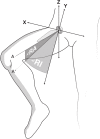Combined and hybrid marker models for radiostereometry assessment of polyethylene liner motion in dual mobility hip prosthesis: a proof-of-concept study
- PMID: 34907467
- PMCID: PMC8671599
- DOI: 10.1186/s41747-021-00253-x
Combined and hybrid marker models for radiostereometry assessment of polyethylene liner motion in dual mobility hip prosthesis: a proof-of-concept study
Abstract
Background: Investigation of polyethylene liner movement in total hip arthroplasty requires bead-marking for radiographic visibility of the liner. However, occlusion of markers poses a challenge for marker registration in radiographs.
Methods: The polyethylene of a dual mobility acetabular system was marked with twelve 1-mm tantalum markers (four groups of three markers) using a custom-made drill guide. Liner motion in a phantom and a patient was investigated with dynamic radiostereometry analysis (dRSA) at 1-year follow-up and static radiostereometry analysis (sRSA) postoperatively and at 1- and 2-year follow-up. A combined marker configuration (CMC) model was calculated from the registered positions of the liner markers and the femoral head in several images. Furthermore, the CMC model and the theoretic marker positions from computer-assisted models of the drill guide were combined in a hybrid model.
Results: The CMC model included eleven markers in the phantom and nine markers in the patient, which was sufficient for dRSA. Liner movement in the phantom followed liner contact with the femoral neck, while liner movement in the patient was independent. The hybrid model was necessary to determine liner orientation in sRSA recordings, which clearly changed from postoperative to 1- and 2-year follow-up even though the patient was positioned similarly.
Conclusion: Polyethylene liner motion in dual mobility hip prosthesis can be assessed with CMC models in dRSA recordings. In sRSA, the liner position between follow-ups is unpredictable and analysis requires inclusion of all markers in the model, accomplished with a hybrid marker model.
Trial registration: ClinicalTrials.gov [ NCT02301182 ], 25 October 2015.
Keywords: Hip prosthesis; Phantoms (imaging); Polyethylene; Radiography; Radiostereometric analysis.
© 2021. The Author(s) under exclusive licence to European Society of Radiology.
Conflict of interest statement
None of the authors has conflicts of interest regarding this article.
Figures






References
-
- DHR . National report 2019, The Danish Hip Arthroplasty Register, Regionernes Kliniske Kvalitetsudviklingsprogram. 2019.
Publication types
MeSH terms
Substances
Associated data
LinkOut - more resources
Full Text Sources
Medical
